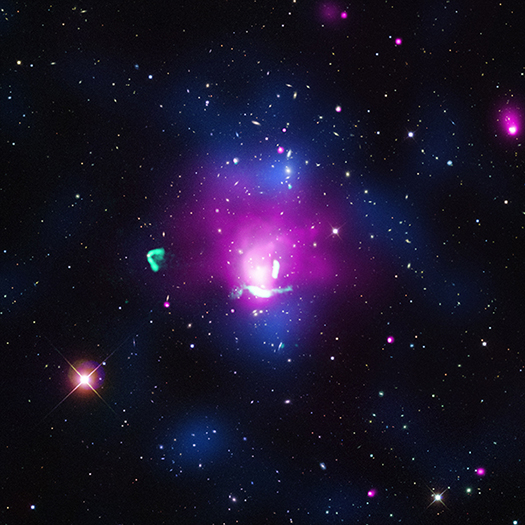Chandra Data Suggest Giant Collision Triggered "Radio Phoenix"

Astronomers have found evidence for a faded electron cloud "coming back to life," much like the mythical phoenix, after two galaxy clusters collided. This "radio phoenix," so-called because the high-energy electrons radiate primarily at radio frequencies, is found in Abell 1033. The system is located about 1.6 billion light years from Earth.
By combining data from NASA's Chandra X-ray Observatory, the Westerbork Synthesis Radio Telescope in the Netherlands, NSF's Karl Jansky Very Large Array (VLA), and the Sloan Digital Sky Survey (SDSS), astronomers were able to recreate the scientific narrative behind this intriguing cosmic story of the radio phoenix.
Galaxy clusters are the largest structures in the Universe held together by gravity. They consist of hundreds or even thousands of individual galaxies, unseen dark matter, and huge reservoirs of hot gas that glow in X-ray light. Understanding how clusters grow is critical to tracking how the Universe itself evolves over time.
Astronomers think that the supermassive black hole close to the center of Abell 1033 erupted in the past. Streams of high-energy electrons filled a region hundreds of thousands of light years across and produced a cloud of bright radio emission. This cloud faded over a period of millions of years as the electrons lost energy and the cloud expanded.
The radio phoenix emerged when another cluster of galaxies slammed into the original cluster, sending shock waves through the system. These shock waves, similar to sonic booms produced by supersonic jets, passed through the dormant cloud of electrons. The shock waves compressed the cloud and re-energized the electrons, which caused the cloud to once again shine at radio frequencies.
A new portrait of this radio phoenix is captured in this multi wavelength image of Abell 1033. X-rays from Chandra are in pink and radio data from the VLA are colored green. The background image shows optical observations from the SDSS. A map of the density of galaxies, made from the analysis of optical data, is seen in blue. Mouse over the image above to see the location of the radio phoenix.
More information at http://chandra.harvard.edu/photo/2015/a1033/index.html
-Megan Watzke, CXC
Please note this is a moderated blog. No pornography, spam, profanity or discriminatory remarks are allowed. No personal attacks are allowed. Users should stay on topic to keep it relevant for the readers.
Read the privacy statement
